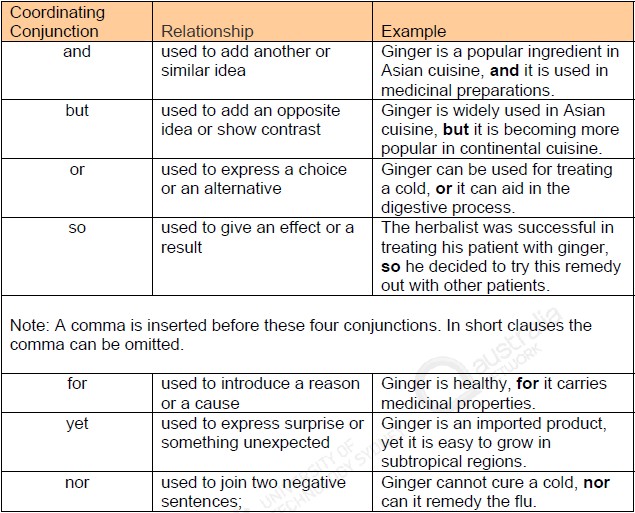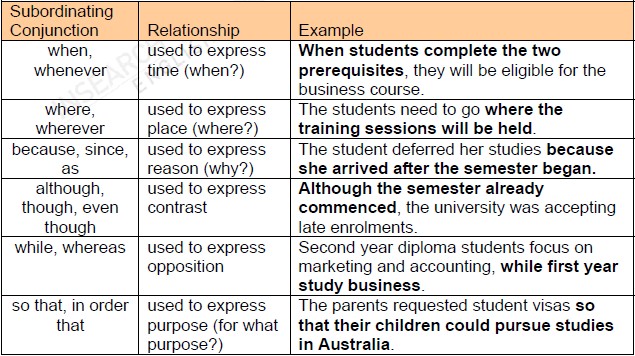Today we’re going to look at ways of connecting ideas. There are many ways of doing this using ‘conjunctions’, words that join.
First, let’s listen to Paul Gibson, an architect, while he takes us on a tour of his new, environmentally friendly solar house.
Well we completed it about 2 years ago, and I guess one of the interesting things about it is that it’s a fibro house and most houses I guess these days are brick veneer, whereas this is fibro on the outside, timber on the outside, but there’s bricks on the inside.
Well I guess the very high windows along the north side going down to the lower ceiling height on the south basically allows you to get a lot of sun in through these windows in winter, and the louvres, which go out, actually go to a point where the sun can be shaded completely in summer, but they can be opened to let the sun right back into the house though winter.
This house actually has 2 north faces. There’s the north face of all the living rooms, 3 actually, and then the master bedroom has a north face and the other bedrooms also have a north face. So it’s trying to maximise what we call the aperture of the house, which is how much sun you actually get in winter.
OK, now we’ve listened to Paul, let’s look at the way he connected his ideas.
Good communication, especially in an academic setting, is all about expressing and connecting both simple and complex ideas.
There are many ways to do this.
Simple sentences express a single, simple idea.
The most simple sentence consists of just a ‘subject’ and a ‘verb’.
- ‘The door opens.’
- ‘The woman enters.’
The easiest way of connecting ideas is using ‘coordination’.
That’s taking 2 simple sentences, and linking them with a ‘conjunction’ or joining word.
The most common conjunctions are ‘and’ and ‘but’.
Other common ones are ‘yet’, ‘or’, ‘for’, and ‘so’.
We use the most simple conjunctions in place of a ‘full stop’.
- ‘The door opens.’ ‘The woman enters.’
- ‘The door opens and the woman enters.’
- ‘The door opens.’ ‘The woman doesn’t enter.’
- ‘The door opens but the woman doesn’t enter.’
Listen to an example here.
Well we completed it about 2 years ago, and I guess one of the interesting things about it is that it’s a fibro house and most houses I guess these days are brick veneer.
It’s a fibro house and most houses are brick veneer.
- ‘It is a fibro house.’
- ‘Most houses are brick veneer.’
These are 2 simple sentences.
They can be linked together to form a longer sentence called a ‘compound sentence’.
- ‘It is a fibro house and most houses are brick veneer.’
Compound sentences have 2 ‘independent clauses’, 2 clauses that can be separate sentences.
Here’s another one.
The ceiling height on the south basically allows you to get a lot of sun in through these windows in winter, and the louvres, which go out, actually go to a point where the sun can be shaded completely in summer, but they can be opened to let the sun right back into the house though winter.
He’s talking about the louvres.
He joins together two sentences.
- ‘The louvres go to a point where the sun can be shaded completely in summer.’
- ‘They can be opened to let the sun back in through winter.’
He joins these sentences together using ‘but’. Notice we use a ‘comma’ as well.
- ‘The louvres go to a point where the sun can be shaded completely in summer, but they can be opened to let the sun back in through winter.’
The conjunctions ‘and’ and ‘but’ can also be used to join words and phrases in lists.
We separate words with ‘commas’, and then use a final ‘and’.
‘The house is made of fibro.’
- ‘The house is made of fibro and timber.’
- ‘The house is made of fibro, timber and bricks.’
Listen to this example.
Most houses I guess these days are brick veneer, whereas this is fibro on the outside, timber on the outside, but there’s bricks on the inside.
He forms one compound sentence from simple sentences.
- ‘The house is fibro on the outside.’ ‘It is timber on the outside.’ ‘It is bricks on the inside.’
Notice that ‘and’ is used to list similar things, ‘but’ is used to contrast different items in a list.
So we could also say:
- ‘The house is fibro and timber on the outside, but bricks on the inside.’
OK, so that’s an introduction to ‘coordination’,
Remember ‘coordination’ is ‘linking independent clauses with conjunctions’. This forms ‘compound sentences’.
Another way to join ideas is using ‘subordination’.
‘Subordination’ is linking an independent clause with a dependent clause to make a complex sentence.
‘Dependent clauses’ are clauses that cannot exist separately, in separate sentences. They need or depend on each other.
We can form ‘complex sentences’ in two ways.
We can use ‘relative pronouns’: who, whose, which, where; or we can use ‘conjunctions’: because or whereas.
When writing or speaking, it’s important for you to practise using a variety of sentences. You’ll need to use simple, compound and complex sentences.
Here’s another example.
Trying to maximise what we call the aperture of the house, which is how much sun you actually get in winter.
He uses an independent and a dependent clause here.
Look at these 2 sentences.
- ‘They are trying to maximise the aperture of the house.’
- ‘The aperture of the house is how much sun you get.’
He joins these 2 sentences together with a relative pronoun.
- ‘They are trying to maximise the aperture of the house, which is how much sun you get.’
Now let’s practice that. Join these simple sentences to make compound sentences using ‘coordination’.
Here, try to use ‘and’ and ‘but’.
- ‘The master bedroom has a north face.’ ‘The other bedrooms have a north face.’
- ‘The master bedroom and the other bedrooms have a north face.’
And here’s another one.
- ‘The house is warm in winter.’ ‘The house is cool in summer.’
- ‘The house is warm in winter, but it’s cool in summer.’
Now let’s practice ‘subordination’. That’s making 2 sentences into one complex sentence.
Try using ‘whereas’.
- ‘The house is warm in winter.’ ‘Most houses are cold in winter.’
This can become:
- ‘The house is warm in winter, whereas most houses are cold in winter.’
And here’s another one. Here, try to link the sentences using ‘which’.
- ‘The house is made of fibro.’ ‘Fibro is a cheap, building material.’
- ‘The house is made of fibro, which is a cheap building material.’
You’ll need to practise forming simple, compound and complex sentences. There are many ways to do it, and many different ways of punctuating. This is very important for your written work.
And that’s all for today. I’ll see you next time on Study English. Bye bye.
Study Note
Coordination is used to connect ideas that are of equal importance, joining independent clauses, which express ideas of equal content. An independent clause is, in fact, a simple sentence.
Subordination is used to connect main ideas with supporting ones. Sentences of this type join independent clauses with dependent clauses or phrases.
Conjunctions are used to join ideas together. There are two types of conjunctions – coordinating and subordinating.
Coordinating conjunctions join independent clauses (simple sentences) to form compound sentences.
There are seven coordinating conjunctions: and, but, or, so, for, yet, nor. Each expresses a different relationship between the clauses.
Subordinating conjunctions connect a dependent clause to an independent clause to form a complete sentence, which is called a complex sentence.
There are a number of different dependent clauses, for example dependent adjective clauses anddependent adverb clauses. The subordinating conjunctions used in the various clauses express a variety of different relationships with the dependent clauses.
Complex Sentences with dependent adjective clauses
Adjective clauses provide information about a noun or pronoun. They are sometimes referred to as relative clauses because they begin with a relative pronoun, such as who, whom, which, that or a relative adverb, such as when, where.
Complex Sentences with dependent adverb clauses
Adverb clauses provide the following kind of information: when, where, why, for what purpose, and so on.
The punctuation of a complex sentence with a dependent adverb clause is contingent on the order of the clause in the sentence. A comma separates the clauses only when the dependent clause comes first.


